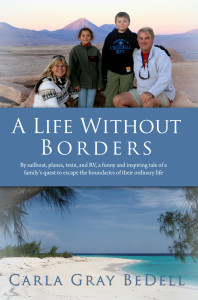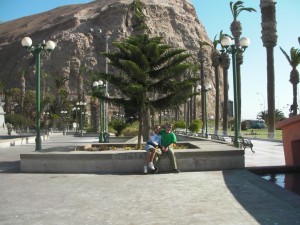 Plaza in Arica
Plaza in Arica
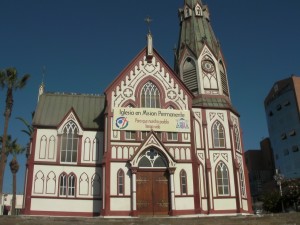 Iglesia San Marcos designed by Alexandre Gustave Eiffel (same man who designed the Eiffel Tower) It’s made entirely of stamped and molded cast iron, prefabricated in Paris and reassembled in Arica.
Iglesia San Marcos designed by Alexandre Gustave Eiffel (same man who designed the Eiffel Tower) It’s made entirely of stamped and molded cast iron, prefabricated in Paris and reassembled in Arica.
This is how it was supposed to work. The bus from Puno would drop us off at the bus station in Tacna, we would get into a collectivo ( a small van carrying about 12 people) that would take us across the border to Arica and hopefully drop us off at the bus station in Arica where we would find a tourist booth and a someone who spoke english could help us find a hotel. Here’s what really happened.
The bus didn’t drop us off at the bus station, instead we were dropped off in some alleyway in Tacna. This must have been common practice as there were several cab drivers waiting. Well, they weren’t actually waiting, they were yelling in Spanish, jostling each other, trying to get passengers attention. Bleary eyed we got our luggage, and headed out of the alley. We were immediately swarmed with taxi offers. The problem was we didn’t know where to go, and with all the confusion, it was hard to think. We had heard you caught the cabs or collectivos to Chile at the bus station. After looking around and realizing the bus station was no where near, we picked a taxi and explained, as best we could with a lot of hand motions, where we needed to go. Luckily he understood, and this bought us a little time to try and come up with a plan.
As we pulled into the bus station, a man ran up to the cab and chased the cab into the bus station parking lot. He was saying something we couldn’t understand and our cab driver was yelling at him. As soon as our cab stopped, he was there, along with 4 other guys trying to get our business. We had been warned by an American we met that you needed to really watch your luggage at the Tacna bus station. In confusion, just like this, his computer had been stolen. Of course we had been warned at every bus station to watch our luggage. By this time our luggage had expanded. In addition to our backpacks and 2 small rolling suitcases, we had 2 more soft Peruvian backpacks to store our sleeping bags, and one soft Peruvian duffel bag that held our dirty clothes and souvenirs. What was our plan for keeping the luggage from getting stolen? Tessa. She was our go to girl. Dan, Tristan and I would unload the luggage and Tessa would guard it. It may seem strange to you to have a nine year old girl keeping guard, but it worked. Who would steal from a little girl???
So our luggage is out of the car, Tessa is keeping watch, and the taxi drivers have gotten into a shoving match over who is going to help us. What do we do in situations like this? We just walk away. They all followed us into the terminal, yelling in Spanish how much they would charge. At least that’s what we think they were yelling as we couldn’t understand them. We walked around the small terminal aimlessly, not sure what to do. One guy stayed with us, and I understood he would charge us 15 Sols per person to take us across the border to Arica. This was not a simple thing. It was about an hour to the border, wait in line, help us cross, then drive another half hour or so to Arica. For $18.00 US total, it sounded like a great deal. Dan always asks me in times like this, with several tourist operators or several taxi drivers crowding around, how do I know which one to go with? Faith and intuition. And I look at their eyes. If I intuitively feel they are ok, and they have nice eyes, they get our business. Simple. Our taxi driver ended up being the one who chased our cab down as we drove in. Even though someone later came up to us and told us he would take us for 10 Sols, we kept our guy.
The drive was uneventful. We made small talk with the driver as best we could. He spoke no English, so there was a lot of hand motions. Normally we are much better with Spanish, but today we were off our game. We have an interesting approach to interpreting and speaking the language. Dan and especially Tristan are great at hearing it. If they hear it, they can usually understand it. Dan won’t speak it though, and Tristan will sometimes speak. I am much better at speaking and reading Spanish. In fact, when someone speaks Spanish to me, I find that I’m not really listening to it as much as I am looking at them, looking at their eyes for visual cues as to what they are saying. It makes you stay very present moment, very present in the conversation. A lot of people, including myself sometimes, in a normal conversation, are generally fixated on what they are going to say, and only partially listen to the speaker. When you don’t know the language, you have to really pay attention and get all the clues you can. You can’t be thinking of an answer if you can’t understand the question.
Our first stop was checking out of Arica. Leaving our luggage in the taxi, we had to walk through the checkout procedure and wait on the other sidefor the taxi driver to pick us up. Our driver, Gustav, was very helpful, getting us to the front of the line and quickly through. Next, a short ride down the road and we were checking into Chile. Chile has a visa reciprocity with the US. The US charges a high visa fee for Chileans coming into the US and the Chileans charge an equally high fee for US cititzenscoming into Chile. We caught a break here. After our immigration officer thoroughly checked our passports, our fee was waived. It seems the fee applies only to those who fly in, not come on the bus. There was a little concern about when we had been in the US due to the swine flu, but our passports clearly showed we had spent the last months in Peru, Aruba and Curacao. We were checked through without a problem, and back in the taxi for the short ride to Arica.
We asked Gustav to drop us off at the bus station, again thinking we could get some hotel information. Instead he dropped us off at a taxi parking lot we thinkwas close to the bus station. As we unloaded our bags, again unsure what to do, Gustav started talking to a Chilean man. It turned out this was the “Money Man”. Gustav knew we would need to get some Chilean Pesos and this was the Money Exchange man. We had a vague idea of the exchange rate but we really weren’t prepared for it. The rate at the time was $567.00 Chile Peso to $1.00 US dollar. We gave Exchange Man some money and he gave us back $1000.00 Peso bills. In Spanish I asked Gustav if this was the correct exchange rate so we weren’t getting ripped off and he said it was. We then asked “Cuanto cuesta taxi?” or how much is the taxi. Sometimes, actually a lot of times, I get mixed up and ask “Cuanto quesa?” or How much cheese?, but this time I got it right. We couldn’t understand his answer because now the amounts were in mil or thousands, so he tooksome money, folded it up, gave it to Dan and said taxi. That cleared it up. A taxi should run us 1500 pesos. We thanked him for his help, then consulted the Lonely Planet guide on what hotel to go to. We decided we might try the Sunshine Hostel. It had good ratings on the internet. Dan hailed a taxi, and we told him the name of the Hostel, which was supposed to be near the bus stop, but he never heard of it. Dan showed him the address in the guidebook and he drove us there. The Sunshine Hostel did not live up to its name on the outside. It seemed to me we weren’t in a very good part of town. The kids andI stayed in the taxi while Dan went to check it out. He came back and told us the place was locked up and he didn’t see anyone around, so we were back to the guidebook. I had another one picked out, close to the Plaza (again, when all else fails, find a hotel near the Plaza) and we showed the driver the address. On the way there though, I had second thoughts, as the price seemed high, and I changed my mind and gave him another address. He was very nice, and wasn’t the least upset with the driving around and our inability to converse with him in Spanish. I don’t know if it was the dialect, it was too early in the morning, or the Chilean people spoke too fast for us, but we couldn’t understand what he was saying. He did get us to the Hotel Sotomayor, which was conveniently located about a block from the Plaza.
This is what the Lonely Planet guidebook says about the Hotel Sotomayor “This central hotel may be a tad faded around the edges but it retains its reputation for extremely courteous service…” It was faded, but the room, with 1 doulbe and 2 twin beds was clean and the manager without asking, took $10.00 US off the price. Breakfast was included, so was internet. Bellhops carried our bags to the room and refused a tip. The elevator was very small, enough for 2 people and 1 bag of luggage. Tristan refused to ride in it. For $50.00 a night, right next to the Plaza, in a resort town, it was a great deal.
Arica is not a big city. The population is about 185,000 people. It is located on the Pacific Ocean and is a beach resort town, complete with casinos. From the first moment we knew we weren’t in Peru anymore. First, while the people at the hotel and the lady at the empanada stand we had lunch at, were nice, they weren’t the same nice as Peru. In Peru, the pace was slower, even in the larger cities, and people smiled and seemed genuinely interested in us. In Chile, it was the hectic pace of life in America. The people seemed very preoccupied, seemed in a rush, and no one WOULD speak English. I say they wouldn’t speak english, not that they couldn’t, as many signs were in english, english music played everywhere (in the malls, in taxis), and movies were english with spanish subtitles. They wouldn’t have all this if people weren’t capable of speaking/understanding english. It was very frustrating, because if you pinned them down, they would understand what you were saying, but they didn’t like it. I really got the feeling that they weren’t that enthused about Americans. They also just didn’t have the beauty and grace of the Peruvian people. Now, of course, not all were unfriendly, (and it wasn’t so much unfriendly as uninterested), but they definitely were “hurried”.
Our hotel staff couldn’t do enough for us, even stopped using their work computer to let me on to look up hotels. The city was alive and bustling at night and we had some great people watching. We even enjoyed a movie. So Arica wasn’t all bad, but we didn’t stay there long. We had two areas of Chile we wanted to see before heading back. The first was San Pedro de Atacama, a high plains desert where we were going to view the stars in the clear desert night, and La Serena, back on the coast, to take a boat to a remote island to see the penguins. The next evening we were back on the overnight bus to San Pedro de Atacama, the place we would all fall in love with.
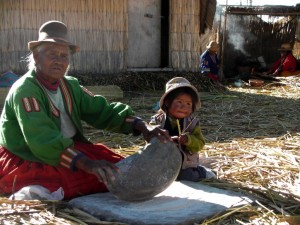 Uros Reed Islands
Uros Reed Islands
The next leg of our journtey turned out to be a long one. We took the overnight bus from Cusco to Puno. The road was a rougher and it was much colder as we were headed high over the Andes. I’m glad we brought our sleeping bags.
A little information about bus travel. Before this trip, we had never, ever been on a long distance bus and really had no desire to. In Peru, however, that is the main form of travel. The bus lines we took were generally nice, double decker buses, VIP areas with bigger seats, and onboard videos. Of course the kids loved it. Anything that’s different from what they are used to they love. For example they love roll down windows on cars. They think that’s so cool. The seats on the buses are comfortable with the VIP seats on the bottom being better as they are bigger, lay flatter and also you don’t feel the bus lean over as much when the driver is barreling down a mountain, around hairpin turns. The restrooms are generally clean though hard to use when the bus is really moving. I tried to plan it when the bus was stopped but you could never really count on that. The bus was stopped one time and I felt it would be alright to get up. It was late, and the bus was dark. No sooner had I gotten my seatbelt unbuckled then we started up again. I decided to chance it. Normally when you are walking to the back of the bus, you can put your hands on the seatbacks to steady yourself. I did this in the dark, forgetting the seats were reclining. My hand missed the seat back and instead my fingers became embedded in someone’s thick curly hair, no doubt belonging to the hippie guy with the curly red afro that was seated a few seats behind us. YUK! I heard a small cry as I wrenched my hand free and scurried away, hoping he wouldn’t see me. After this, I would not leave my seat.
The bus pulled into Puno around 6 am, fortunately into a bus station. As we stumbled inside we were overwhelmed by tourist people trying to sell us tours to Lake Titicaca. Before we decided on the tour, we wanted to check on the bus schedule. We kept fending off the tourist people, trying to find a bus line that would head from Puno to Tacna. One lady stayed with us and helped us out, recommending a bus line and times. She also sold tours to Lake Titicaca. Looking at the bus schedule, we realized we could tour Lake Titicaca all day, then board an over night bus that evening to Tacna. From Tacna you take a cab across the border to Arica Chile where we would get our next hotel room. It was a workable, if ambitious plan. After getting our ticket, our tourist lady took us upstairs to the cafeteria and helped us get breakfast, while she talked about the tour. The tour company would take us to the docks. We would board a boat that would take us to 3 islands. The first islands were the Uros floating islands about an hour away. Then the boat would take us to the island of Taquile, 2 hours away. We would eat lunch there and be back at the bus station by 6 pm, in time to catch our next bus leaving after 9:00 pm. The price was great, $10 US for adults and $8.00 for the kids and it was scheduled to leave at 7:30am. That gave us just enough time to eat, brush teeth and be on our way again. We were able to stow our luggage at the tourist office. (Again, not locked up and given a receipt as Lonely Planet warns, but just stashed in a corner.) We kept our backpacks with us, including our electronics. Our backpacks were heavy, but we didn’t think we’d have much hiking.
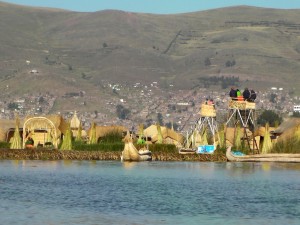
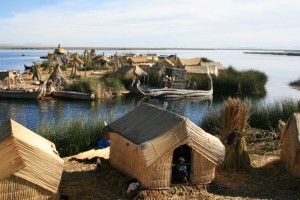 Islands entirely man made of reeds
Islands entirely man made of reeds
Our first stop was the Uros Islands. These are man made islands from reeds. The islands were built originally by the Uros tribes to isolate themselves from conquering tribes such as the Incas. Several hundred people still live on the islands today, mainly the very young children and the elders, while the teenagers and young adults have moved off. The lifespan on the island is sadly only fifty years or so. While sad, it’s not surprising as it just didn’t seem healthy spending your whole life on floating, decaying reeds.
The islands are constructed from many layers of reeds, stacked into floating blocks eventually getting about 3 feet in thickness, anchored in place. Every 2 weeks a new layer of reeds is added and every 30 years, the natives need to redo the island, burning the old one. While the reeds are pretty, I found the whole place uncomfortable. It was like walking on a waterbed. The people weren’t very friendly either, arguing over potential customers looking at their crafts. And the children. I couldn’t imagine where they would play. While it was phenomenal what they did in building the islands, Tristan was especially fascinated, hanging on every word the tour guide said, the whole place just didn’t feel good to me.
 How the reeds are bound
How the reeds are bound
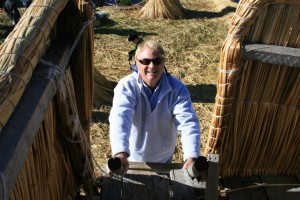 Dan climbing to the lookout post
Dan climbing to the lookout post
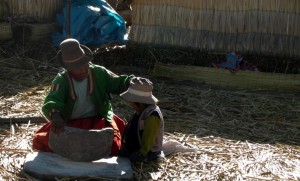 Grandmother and child
Grandmother and child
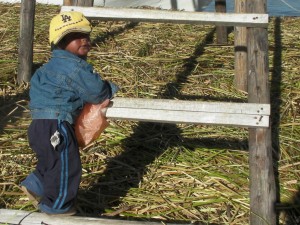 Young Ural boy
Young Ural boy
The trip to
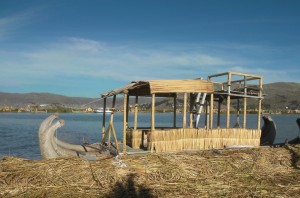 Reed boat
Reed boat
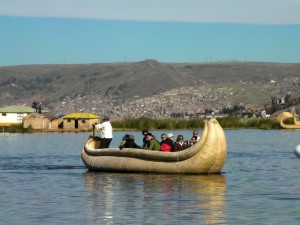 Dan and the kids took a ride on this beautiful reed canoe
Dan and the kids took a ride on this beautiful reed canoe
Dan and I slept the 2 1/2 hours to the Taquile islands. We woke up just in time to hear our guide talk about the Taquile natives. The Taquile islanders made the the Uros islanders seem downright jovial. This island had the least amount of visitors and they were heavily steeped in the old customs. Our guide was great explaining the traditions around the headwear. All men wear hats, but which color hat they wear, tells you something about them. Single men wear red hats and single men wear more elaborately designed red and white hats. There is a special hat for the tribal leader to wear and each man becomes a tribal leader for 1 year. By the way, the men knit the hats themselves. We saw several men sitting in the plaza, knitting away. Our guide also told us about the importance of hair to the Peru men and woman. It’s a great source of pride (as we already figured out). Women only cut their hair once in their life, when they marry. Male babies have their hair cut at age 2 in a ceremony where braids are made in the baby’s hair, and each member of the community brings a gift and is then allowed to cut one of the braids. The gifts may consist of animals, money or coca leaves. She explained that the coca leaves are important in the lives of the community, and are a huge source of calcium, magnesium and other beneficial vitamins and minerals. This is what makes the hair and teeth of the Peruvians so perfect. The coca is so important to the Peruvian people that they are included in nearly every ceremony. The Taquile men take it one step further. They carry a woven bag filled with coca leaves. When they greet other members of the community, instead of shaking hands, they exchange handfuls of coca leaves. The leaves are grown on the island as is nearly everything the Taquiles need. They prefer to keep to themselves. But apparently they like the money from the tourist.
The Taquiles were heavily influenced by the Spanish. Where the Uros women wore the traditional bola hats seem throughout most of Peru, the Taquile women wear the shawls covering their heads, very reminiscent of Spanish women. They don’t like their picture taken without being paid. What pictures I did get involved covert actions.
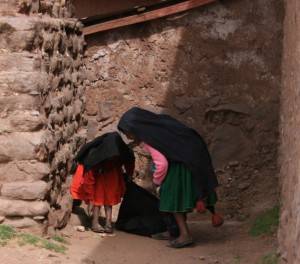 Young girls wearing the traditional head covering, with pom poms on the ends
Young girls wearing the traditional head covering, with pom poms on the ends
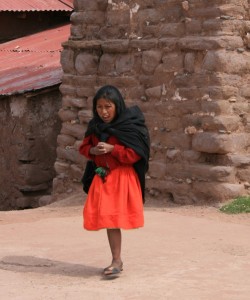
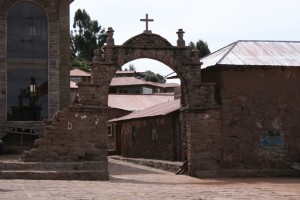 In the Plaza
In the Plaza
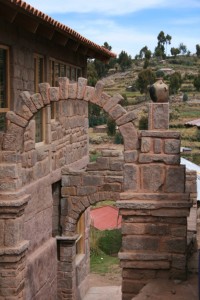
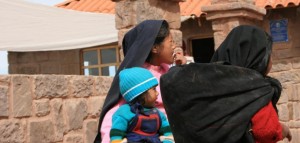
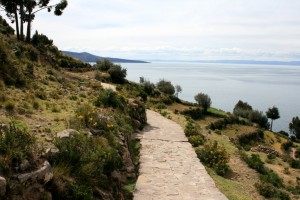 Path alongside the island
Path alongside the island
The island itself was pretty. As soon as we got off the boat, we had 500 steps to climb to the top. Five hundred steps, at an altitude of over 12000 feet, it took awhile for us to make it to the top. There we had time for a delicious lunch of fresh trout, served under a canopy, overlooking Lake Titicaca. We struck up a conversation with a Brazilian couple across from us. He spoke some english, his wife only Portuguese. They loved the United States and a few years ago had rented an RV with some Brazilian friends and drove from New Orleans to Minnesota, having a great time. They reminded us alot of Lillian and Sylvio our Brazilian friends we met in the Curacao boatyard. After lunch it was up another 100 stairs or so to the Plaza, where we could look at the islanders handiwork. Then we had 30 minutes to follow the paved path around the island and down to the boat. Our guide warned us to be prompt getting back to the boat as they would leave on the dot, without us. Apparently after a certain hour in the afternoon, the wind whips the waves up to an unsafe height for the boats, so they need to depart before this happens. In fact we almost left the Brazilian couple as they were late getting back. They weren’t very happy!
We slept the 2 1/2 hours back to Puno. There were still a few hours to kill before we boarded the bus again, so we had the van drop us off downtown. After an unusually good (for Peru) pizza, it was back to claim our luggage from the tourist company and wait for the bus. For this overnight trip we were finally able to get the VIP seats on the lower level. This trip used to be really bad as it’s up and over higher mountains, then straight down to nearly sea level. The old road didn’t used to be paved, but they assured us now a new road had been built. And it wasn’t bad. The road was still a little rough, it was cold and the bus still swayed a bit around the corners, but we were all so tired we didn’t mind. Six am came again too early, and as the bus stopped in Tacna we sighed with disappointment as once again we were being dropped in the middle of nowhere.

